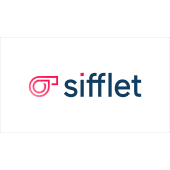Description

Exasol

Sifflet
Comprehensive Overview: Exasol vs Sifflet
Exasol
a) Primary Functions and Target Markets
Primary Functions: Exasol is a high-performance, in-memory, MPP (Massively Parallel Processing) analytical database. Its primary function is to enable fast data analytics and address large-scale data warehousing requirements. Key features include in-memory processing, high-speed analytics, integration capability with other BI tools, and advanced analytics through integration with languages like Python, R, and Java.
Target Markets: Exasol primarily targets businesses with substantial data analysis needs across various sectors such as finance, retail, telecommunications, and healthcare. It's particularly suitable for organizations that require real-time analytics and high-speed data processing to inform business decisions.
b) Market Share and User Base
Exasol is known for its performance, but its market share is smaller compared to giants like Oracle, Amazon Redshift, or Snowflake. It typically appeals to enterprises and mid-sized organizations that need rapid analytical capabilities and are looking for alternatives to larger and possibly less nimble data warehousing solutions. While specific user base numbers are proprietary, Exasol has a regional stronghold in Europe and is expanding globally.
c) Key Differentiating Factors
- Performance: Known for its speed and efficiency, especially with large-scale data.
- In-Memory Technology: Uses high-performance in-memory computing to accelerate query performance.
- Ease of Integration: Seamless integration with various BI tools and open-source analytics languages.
- Cost Efficiency: Offers competitive pricing models, potentially lowering total cost of ownership.
- Customization and Control: Provides more control over the environment compared to some managed services.
Sifflet
a) Primary Functions and Target Markets
Primary Functions: Sifflet is a data observability platform focused on ensuring data reliability through comprehensive monitoring, alerting, and resolving data issues across the data lifecycle. It aims to improve data quality by automating the detection of anomalies, thus helping data teams maintain trust in their data.
Target Markets: Sifflet targets data-driven organizations across various industries, specifically those with mature data infrastructures that rely heavily on data analytics and reporting. Ideal for data engineering teams, Sifflet benefits organizations where data observability can improve operational efficiencies and data reliability.
b) Market Share and User Base
Data observability is a growing niche within data management and currently has fewer established players than traditional data analytics markets. Sifflet is part of a new generation of data observability platforms and is gaining traction, but it does not yet have the market share of larger, more established data tool companies.
c) Key Differentiating Factors
- Focus on Observability: Specifically designed to enhance data reliability and quality through observability.
- Automation: Leverages machine learning to automate anomaly detection and issue resolution.
- User-Friendly Interface: Offers an intuitive platform that facilitates quick adoption and use.
- End-to-End Coverage: Provides comprehensive monitoring across the data lifecycle, from ingestion to consumption.
- Integration with various data platforms: Works alongside existing data stacks, complementing, rather than replacing, existing tools.
Comparison Summary
While Exasol and Sifflet operate within the broader data ecosystem, they serve different purposes. Exasol is an analytical database solution focused on speed and performance for executing complex queries, whereas Sifflet is centered on improving data quality and reliability through observability. Their target markets overlap in terms of data-centric organizations, but they address distinct challenges within the space. Exasol's differentiation lies in performance and integration, while Sifflet focuses on data quality, automation, and reliability.
Contact Info

Year founded :
2000
+49 911 239910
Not Available
Germany
http://www.linkedin.com/company/exasol-ag

Year founded :
2021
+33 7 61 24 62 57
Not Available
France
http://www.linkedin.com/company/sifflet
Feature Similarity Breakdown: Exasol, Sifflet
Exasol and Sifflet are both platforms that serve different primary purposes: Exasol is a high-performance, in-memory, MPP (Massively Parallel Processing) analytical database, while Sifflet is a data observability platform. Comparing these two products directly might not result in many shared features since they serve different functions within the data ecosystem. However, we can still identify some areas of comparison, especially regarding data handling and analytics-related functionalities.
a) Core Features in Common
-
Data Integration:
- Both platforms provide capabilities for integrating with various data sources. Exasol supports a wide array of data connectors and import functionalities, allowing it to fit seamlessly into complex data environments. Sifflet integrates with data warehouses, databases, and pipelines to monitor and analyze data.
-
Analytics and Insights:
- While Exasol is primarily built for performing advanced analytics directly within its environment, Sifflet uses its integration with data sources to provide insights into data quality and health.
-
Scalability:
- Both are designed to handle large-scale data operations, although Exasol focuses on analytic workloads, whereas Sifflet scales in terms of data observability across large data ecosystems.
b) User Interface Comparison
- Exasol:
- Exasol's interface is typically designed for data engineers, scientists, and analysts who need to execute queries, visualize performance metrics, and manage data workloads. The UIs are primarily command-line interfaces and SQL-based dashboards, with some tools providing GUI for simpler tasks.
- Sifflet:
- Sifflet’s user interface is geared towards providing an accessible snapshot of data health and intuitive dashboards that allow users to easily monitor and manage data quality. The focus is on clarity and usability for data teams concerned with data observability, featuring visual tools and alert systems.
c) Unique Features
-
Exasol:
- In-Memory Processing: Exasol’s core strength lies in its high-performance, in-memory processing capabilities, providing fast query response times even with large data volumes.
- MPP Architecture: Its Massively Parallel Processing architecture allows for extensive scalability and efficient handling of large datasets.
-
Sifflet:
- Data Observability: Sifflet specializes in ensuring data quality and reliability, offering features such as automatic anomaly detection, data lineage, and root cause analysis which are not present in Exasol.
- Alerting and Monitoring: Advanced alert systems for catching data inconsistencies or outages, as well as ongoing monitoring of data streams, set it apart for users focused on data trustworthiness and operational efficiency.
In summary, while Exasol and Sifflet may have overlapping capabilities in handling large-scale data and providing analytical functions, they are fundamentally aimed at different aspects of data management and analytics. Exasol stands out as a powerhouse for in-memory analytics, while Sifflet shines in data observability and quality maintenance.
Features

Not Available

Not Available
Best Fit Use Cases: Exasol, Sifflet
Exasol and Sifflet serve different purposes in the data management and analytics ecosystem. Below is an overview of their best-fit use cases, catered industry verticals, and company sizes:
Exasol
a) Best Fit Use Cases:
- High-Performance Analytics: Exasol is designed for businesses needing extremely fast data analytics. It’s particularly well-suited for organizations that handle large volumes of data and require real-time, complex analytical computations.
- In-Memory Database Processing: Companies that seek to leverage in-memory database technology to accelerate their business intelligence (BI) operations benefit greatly from Exasol.
- Scalable Data Warehousing: Businesses that need to scale their data warehousing capabilities to accommodate growing data loads will find Exasol's scalable architecture advantageous.
Industry Verticals and Company Sizes:
- Financial Services: For real-time risk analytics and fraud detection.
- Retail and E-commerce: To optimize supply chain, inventory management, and customer analytics.
- Telecommunications: For customer churn prediction and network optimization.
- Primarily aimed at medium to large enterprises, but scalable solutions can also fit smaller companies with significant data needs.
Sifflet
b) Preferred Scenarios:
- Data Discovery and Governance: Sifflet specializes in ensuring data quality and visibility across the data pipeline, making it a good choice for businesses focused on data governance and compliance.
- Data Observability: It is suitable for companies that need to understand, monitor, and manage their end-to-end data processes to ensure reliable data delivery.
- Rapidly Changing Data Environments: Organizations undergoing digital transformation or those with rapidly evolving data landscapes benefit from the observability features offered by Sifflet.
Industry Verticals and Company Sizes:
- Tech and SaaS Companies: For managing complex multi-cloud data environments and ensuring data integrity.
- Healthcare and Life Sciences: Where data governance is critical due to regulatory requirements.
- Consumer Goods: To maintain a consistent and accurate flow of data for better decision making.
- Suitable for a wide range of company sizes from startups needing strong data practices to larger enterprises with intricate data landscapes.
Overall, Exasol is optimal for businesses focusing on high-speed data analytics and processing at scale, whereas Sifflet is favored for its robust data governance and observability solutions. The choice between them largely depends on the specific needs of the business, such as the importance of speed and performance versus data quality and governance.
Pricing

Pricing Not Available

Pricing Not Available
Metrics History
Metrics History
Comparing teamSize across companies
Conclusion & Final Verdict: Exasol vs Sifflet
To provide a conclusion and final verdict for Exasol and Sifflet, we will evaluate these platforms across different aspects such as performance, use case, pricing, support, and any unique features they may offer.
Conclusion and Final Verdict
a) Considering all factors, which product offers the best overall value?
Exasol appears to offer the best overall value if your primary needs include high-speed analytics and a robust, scalable data warehouse solution. It's especially suited for businesses that need to handle large volumes of data with an emphasis on performance and query speed.
Sifflet might provide better value if your main requirement is data observability and lineage. It excels at monitoring data quality, tracing data flows, and ensuring compliance, which are crucial for organizations prioritizing data governance and reliability.
Ultimately, the best value depends significantly on your specific business requirements. If your focus is on analytical power and speed, Exasol stands out. If you need strong data observability, Sifflet is preferable.
b) Pros and Cons of Choosing Each Product
Exasol:
Pros:
- High Performance: Renowned for its speed and capability to handle complex queries efficiently.
- Scalability: Can manage large data volumes, making it suitable for growing businesses.
- Advanced Analytics: Supports a variety of complex analytical functionalities including in-database machine learning.
Cons:
- Cost: Can be expensive compared to other offerings.
- Complex Set-Up: Might require more technical expertise to fully optimize and integrate with existing systems.
Sifflet:
Pros:
- Data Observability: Offers excellent tools for monitoring data pipelines and lineage.
- User-Friendly: Typically easier to set up and use with a focus on intuitive interfaces.
- Focus on Data Quality: Strong emphasis on ensuring data accuracy and reliability.
Cons:
- Niche Functionality: Primarily focused on observability, so it may not provide broad data warehouse capabilities.
- Scalability Concerns: May not handle data analytics at the same scale as Exasol.
c) Specific Recommendations for Users Trying to Decide Between Exasol and Sifflet
-
Define Your Priorities: Clearly outline whether your current emphasis lies on data analytical power or on data observability and governance.
-
Evaluate Data Volume and Complexity: If you're dealing with extensive datasets requiring high-speed analytics, Exasol is more aligned with your needs.
-
Assess Technical Expertise: Consider your team's technical capabilities. Exasol may demand more technical depth to implement effectively compared to Sifflet's more user-friendly approach.
-
Budget Considerations: Review your budget for data tools. Exasol might entail a higher investment, so ensure the performance benefits justify the cost.
-
Future Needs and Scalability: Think about long-term requirements and potential scalability needs. Choose a platform that can scale with your operations efficiently.
Ultimately, making an informed decision requires assessing your organization's specific needs, technical resources, and strategic data goals. Each tool has its strengths, and choosing one over the other should be aligned with your business objectives and data strategy.
Add to compare
Add similar companies




